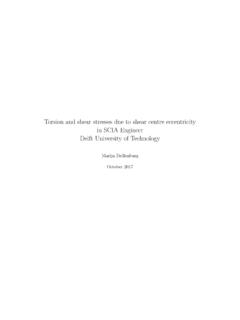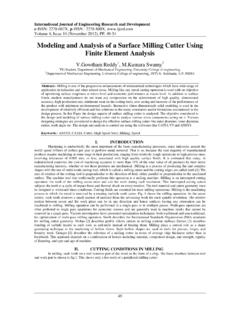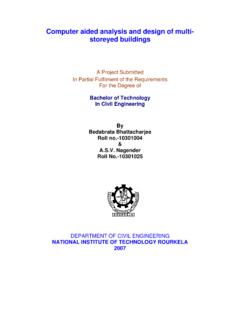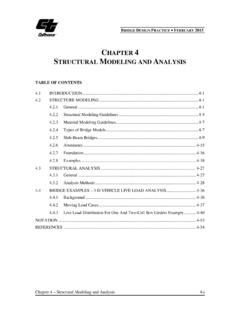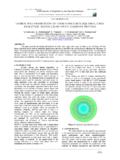Transcription of Structural design of reinforced concrete pile caps - …
1 Structural design of reinforced concrete pile capsThe strut-and-tie method extended with the stringer-panel method van de GraafDecember 2006 Faculty of Civil Engineering and GeosciencesSection Structural Mechanics stringer elementsshear panel elementsstrut elementscolumn loadstrut elementstringer elementsshear panel elementsstrut elementscolumn loadstrut van de Graaf Structural design of reinforced concrete pile caps i van de Graaf Delft, December 2006 Delft University of Technology Faculty of Civil Engineering and Geosciences Section Structural Mechanics Structural design of reinforced concrete pile caps The strut-and-tie method extended with the stringer-panel method van de Graaf Structural design of reinforced concrete pile caps iii Personalia STUDENT Anne Vincent van de Graaf 1040626 + 31 (0)6 12 29 61 32 GRADUATION COMMITTEE Rots (supervisor graduation committee) Delft University of Technology Faculty of Civil Engineering and Geosciences Section Structural Mechanics + 31 (0)15 278 44 90 Hoogenboom (daily supervisor) Delft University of Technology Faculty of Civil Engineering and Geosciences Section Structural Mechanics + 31 (0)15 278 80 81 ir.
2 Peperkamp Delft University of Technology Faculty of Civil Engineering and Geosciences Section concrete Structures + 31 (0)15 278 45 76 ir. Welleman Delft University of Technology Faculty of Civil Engineering and Geosciences Section Structural Mechanics + 31 (0)15 278 48 56 ir. Houben (graduation coordinator) Delft University of Technology Faculty of Civil Engineering and Geosciences Section Road & Railway Engineering + 31 (0)15 278 49 17 van de Graaf Structural design of reinforced concrete pile caps v Preface This graduation report has been written within the framework of a Master of Science Project originally entitled WWW design of reinforced concrete pile Caps. This project was put forward by the Structural Mechanics Section of the Faculty of Civil Engineering and Geosciences at Delft University of Technology.
3 Although I spent a lot of time in mastering the Java programming language and implementing the design model in an applet using Java SE Development Kit (JDK) [ 14 ], not much of this work can be found directly in this report. The same applies to the initial work that I have done in TurboPascal using Borland Delphi [ 13 ]. Therefore, this graduation report is rather brief. For those readers, who are interested in using the applet, please refer to the following web address: Hereby I would like to thank ir. Geers (Faculty of Electrical Engineering, Mathematics and Computer Science at Delft University of Technology) for his advice during the design and implementation of the applet. Many thanks also to ir. den Uijl for his contribution with Atena 3D. And last but not least, I would like to thank Hoogenboom for his support and suggestions during this project.
4 Delft, December 12, 2006 Anne van de van de Graaf Structural design of reinforced concrete pile caps vii Table of contents Personalia ..iii Preface ..v List of symbols ..xi 1 Introduction ..1 2 design problem of the reinforced concrete pile cap ..3 Problem description ..3 Modeling the pile cap ..3 Research outline ..4 3 Mathematical description of the used Co-ordinate systems and Stringer element ..7 Shear panel Strut Element description ..14 Element 4 Assembling the model and solving the system ..23 Assembling the system stiffness matrix ..23 Processing imposed forces ..24 Processing tying ..24 Processing imposed Solving the obtained system of linear equations ..29 5 Applet Applet setup and Java Preprocessor.
5 33 Kernel ..34 Postprocessor ..35 6 Equilibrium Case 1: Symmetrical pile cap consisting of three piles and one column ..37 Equilibrium consideration of the whole structure ..38 Equilibrium consideration of a part of the Case 2: Asymmetrical pile cap consisting of six piles and two columns ..44 Structural design of reinforced concrete pile caps van de Graaf viii 7 Non-linear finite element Geometry of the considered pile cap and material parameters ..47 Ultimate load predicted by pile Cap Applet (PCA)..48 Ultimate load predicted by non-linear finite element analysis ..50 8 Conclusions and recommendations ..57 Appendix A1: Numbering and generating stringer elements ..61 Appendix A2: Numbering and generating shear panel Appendix A3: Numbering and generating strut Appendix B1: Assembling the elements .
6 73 Appendix B2: Generating and processing imposed Appendix B3: Generating and processing tying ..81 Appendix B4: Generating and processing imposed displacements ..85 Appendix B5: Detailed consideration on LU Appendix C: Matrix and vector classes in van de Graaf Structural design of reinforced concrete pile caps ix Summary Many foundations in The Netherlands, mainly those in coastal areas, are on piles. These piles are often over 15 m long at distances of 1 to 4 m. If possible, these piles are driven into the soil at the positions of walls and columns of a building. The presence of piles of a previous building may hamper a free choice of the new pile positions. Removing the old piles is not a solution, because this leaves holes in deep clay layers through which saline groundwater may penetrate into the upper soil.
7 Moreover, the old piles cannot be reused because their quality cannot be guaranteed. As a consequence, pile caps often have to cover piles that are positioned in an irregular pattern. The objective of this Master of Science Project was to develop a design model for calculating the pile loading and reinforcement stresses for pile caps on irregularly positioned foundation piles. This model has been based on the strut-and-tie method, however, the ties have been replaced by another model consisting of stringer elements and shear panel elements . This model predicts vertical pile reactions, reinforcement stresses and shear stresses in concrete . For practical application, it has been implemented in a computer program called pile Cap Applet (PCA). This applet was designed to be user-friendly, to require only a moderate amount of data and to execute fast.
8 PCA has been tested and validated in two ways. Firstly, it has been shown that the design model meets all equilibrium requirements. This has been tested for two pile caps. Both cases revealed that the design model complies with horizontal and vertical force equilibrium and moment equilibrium. From the theory of plasticity it then follows that this model gives a safe approximation of the ultimate load. Secondly, the ultimate load predicted by PCA has been compared to the ultimate load predicted by a non-linear finite element analysis . This comparison yielded several interesting conclusions whereof the most important ones are included in this summary. The ultimate load predicted by PCA is very conservative. Clearly, the real structure can carry the load in more ways than an equilibrium system (PCA) assumes.
9 Furthermore, for the considered pile cap the design model predicted another failure mechanism than the finite element analysis . PCA predicted that the considered pile cap collapsed because of reaching the yield strength in one of the reinforcing bars. In the finite element analysis , the pile cap collapsed because of a shear failure. This failure mechanism cannot be predicted by PCA. For the considered pile cap the vertical pile reactions predicted by PCA are approximately equal to those predicted by the non-linear finite element analysis . However, the reinforcement stresses at serviceability load according to PCA are much higher than those determined by the finite element analysis . This implies that the stresses calculated by PCA are not useful for checking the maximum crack width. van de Graaf Structural design of reinforced concrete pile caps xi List of symbols Latin symbols a length of a shear panel element [mm] b width of a shear panel element [mm] c concrete cover [mm] xd center-to-center distance of reinforcing bars in x-direction [mm] yd center-to-center distance of reinforcing bars in y-direction [mm] cap concreteE Young s modulus of the cap concrete [N/mm2] complE complementary energy [Nmm] pile concreteE Young s modulus of the pile concrete [N/mm2] rebarE Young s modulus of the reinforcement [N/mm2] EA extensional stiffness [N] F external force [N] cap concreteG shear modulus of cap concrete [N/mm2] h depth of the pile cap [mm] N normal force [N] S shear force [N] t effective depth of the pile cap with regard to shear stresses [mm]
10 Iu displacement in direction i [mm] Greek symbols xy shear angle [rad] Poisson s ratio [-] normal stress [N/mm2] shear stress [N/mm2] x reinforcing bar diameter in x-direction [mm] y reinforcing bar diameter in y-direction [mm] Remaining symbol A length of a stringer element or strut element [mm] van de Graaf Structural design of reinforced concrete pile caps 1 1 Introduction It is well-known that many buildings in The Netherlands, mainly those in coastal areas, are founded on piles. These piles can easily reach a length of over 15 m and are usually spaced at distances of 1 to 4 m. If possible, these piles are driven into the soil at the positions of walls and columns. Unfortunately, a Structural designer is not always free in this choice, because piles of a previous building may be present.
